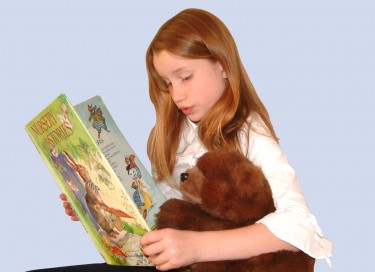 As adults, we have book clubs to discuss topics and themes after we finish reading our book. High school and college literature classes delve into deep conversations and write complex papers about books through the course of their reading. Children should have a similar experience while reading; there is no reason to limit reading a book to simply reading it. Here are some ways you can engage young readers of all ages:
As adults, we have book clubs to discuss topics and themes after we finish reading our book. High school and college literature classes delve into deep conversations and write complex papers about books through the course of their reading. Children should have a similar experience while reading; there is no reason to limit reading a book to simply reading it. Here are some ways you can engage young readers of all ages:
1. Point to pictures and ask questions, even if your baby cannot respond yet. Comment on the story and pictures.
2. Point to pictures and ask your child to identify what she sees. Ask her how she thinks the characters feel. Relate the characters’ actions or the story plot with her own experience. For example, if you are reading Don’t Let the Pigeon Drive the Bus!, you could ask, “Do you ever get upset when you are not allowed to do something?”
3. Ask your child to identify letters and then words when she is older. Help her sound out words. This exercise should be limited, however, as it could become a tiring task and cause your child to lose interest in reading, especially if she feels discouraged. Little by little, though, her skills will improve and reading a word will become a huge confidence builder.
4. Ask your child to make predictions about what she thinks is going to happen in the story. Make your own predictions and see if she agrees.
5. Ask your child questions about what has happened in the story. This is a great intro to reading comprehension and can be done in a way that’s less “schooly” and more conversational.
great intro to reading comprehension and can be done in a way that’s less “schooly” and more conversational.
6. Let your child draw a picture of a story she reads. This will show comprehension and will also give her a chance to build a deeper connection with the story itself.
7. Let your child read the book to you – even if she cannot read yet. Usually she will be summarizing a story she has already read with you or will be telling the story based on the pictures. This is a great way for your child to take ownership of reading and, again, gain confidence in literacy.
8. Create an alternate ending to the book using “what if” scenarios. Let your child be creative and don’t worry about whether or not the events of the story would make her ending feasible.
9. Choose a part of the story to role-play with your child. This is also a great option if you are reading with multiple children. Each can “be” a certain character. They can recreate the events in the story or act out another situation as their character. They will feel connected to the character, and therefore the book itself.
10. Play while you are reading! Change voices to depict different characters and let your child read along with you if she is able. Sing the words of the book to your child’s favorite tune. Let your voice lead the way.
There are countless ways to make reading, especially reading aloud, an exciting and valuable experience for your child. Every kid is different and will prefer a different reading style, so have fun trying out different methods.
Like what you read? Sign up for our free newsletter so you can be informed of the latest FREE webinars & teleclasses, parenting articles, & weekly raffles.
 Lauren Farrell is a private tutor who lives and works in Manhattan. She specializes in literacy development across all age groups and learning backgrounds and focuses largely on building learners’ confidence. To learn more about or to connect with Lauren, visit www.tutorwithlauren.com.
Lauren Farrell is a private tutor who lives and works in Manhattan. She specializes in literacy development across all age groups and learning backgrounds and focuses largely on building learners’ confidence. To learn more about or to connect with Lauren, visit www.tutorwithlauren.com.
* Healthy Living is a section of our website co-hosted by Mott’s. Mott’s has compensated Mommybites to be a partner in this awesome Healthy Living section on our website. This partnership does not influence the content, topics or posts made on this blog. We always give our honest opinions, findings, beliefs, or experiences on all topics, products, and services.
The views and opinions expressed on this blog are purely the blog contributor’s. Any product claim, statistic, quote or other representation about a product or service should be verified with the manufacturer or provider. Writers may have conflicts of interest, and their opinions are their own.



